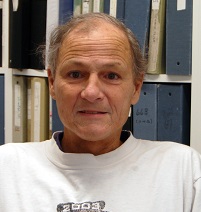LNII Special Volunteer
Bruce W. Chesebro, M.D.
Special Volunteer
Former Chief, TSE/Prion and Retroviral Pathogenesis Section

Major Areas of Research
- Transmissible spongiform encephalopathies (TSEs), or prion diseases
- Retroviral brain diseases
Biography
Education
M.D., 1968, Harvard Medical School
Dr. Chesebro received his M.D. from Harvard Medical School in 1968. He completed postdoctoral studies at the Karolinska Institute, Sweden, in 1967; at Stanford University from 1968 to 1970; and at the National Institute of Arthritis and Metabolic Diseases from 1970 to 1972. He came to NIAID in 1972 and became chief of the Laboratory of Persistent Viral Diseases (now Laboratory of Neurological Infections and Immunity) in 1979. Elected as a Fellow in the American Academy of Microbiology, 2011.
Selected Publications
Carroll JA, Race B, Williams K, Striebel J, Chesebro B. Microglia are Critical in Host Defense Against Prion Disease. J Virol. 2018 May 16. pii: JVI.00549-18. doi: 10.1128/JVI.00549-18 PMID: 29769333
Carroll JA, Chesebro B. Neuroinflammation, Microglia, and Cell-Association during Prion Disease. Viruses. 2019 Jan 15;11(1). pii: E65. doi: 10.3390/v11010065. Review. PMID: 30650564
Race B, Williams K, Chesebro B. Transmission Studies of Chronic Wasting Disease to Transgenic Mice Overexpressing Human Prion Protein using the RT-QulC Assay. Vet Res. 2019 Jan 22;50(1):6. doi: 10.1186/s13567-019-0626-2. PMID: 30670087
Carroll JA, Race B, Williams K, Striebel J, Chesebro B. RNA-seq and network analysis reveal unique glial gene expression signatures during prion infection. Mol Brain. 2020 May 7;13(1):71. doi: 10.1186/s13041-020-00610-8.PMID: 32381108
Race B, Williams K, Striebel JF, Chesebro B. Prion-associated cerebral amyloid angiopathy is not exacerbated by human phosphorylated tau aggregates in scrapie-infected mice expressing anchorless prion protein. Neurobiol Dis. 2020 Oct;144:105057. doi: 10.1016/j.nbd.2020.105057. Epub 2020 Aug 21. PMID: 32829029
Striebel JF, Race B, Leung JM, Schwartz C, Chesebro B. Prion-induced photoreceptor degeneration begins with misfolded prion protein accumulation in cones at two distinct sites: cilia and ribbon synapses. Acta Neuropathol Commun. 2021 Jan 29;9(1):17. doi: 10.1186/s40478-021-01120-x.PMID: 33509294
Patents
Robertson MN, Chesebro B, Miyazawa M, Britt WJ, inventors; The United States of America as represented by the Department of Health and Human Services, assignee. Monoclonal antibodies for detection of friend murine leukemia virus. United States patent US 6,403,300. 11 Jun 2002.
Chesebro BW, Caughey BW, Chabry J, Priola S, inventors; The United States of America as represented by the Department of Health and Human Services, assignee. Inhibitors of formation of protease resistant prion protein. United States patent US 6,355,610. 12 Mar 2002.
Chesebro BW, Caughey BW, Chabry J, Priola S, inventors; The United States of America as represented by the Department of Health and Human Services, assignee. Inhibitors of formation of protease resistant prion protein. United States patent US 6,211,149. 3 Apr 2001.
Chesebro B, Wehrly K, inventors; The United States of America as represented by the Secretary of the Department of Health and Human Services, assignee. Cell lines useful for detection of human immunodeficiency virus. United States patent US 5,811,282. 22 Sep 1998.
Visit the U.S. Patent and Trademark Office for a complete patent listing.

